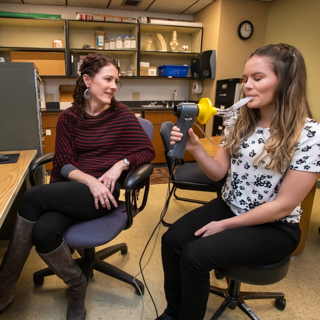Grammar in Aphasia and Bilingualism (GAB) Lab
Mission
The mission of the Grammar in Aphasia & Bilingualism (GAB) Lab (P.I. Danielle Fahey, Ph.D.) at the University of Montana is to investigate the neural bases of syntax (grammar) by aphasic, bilingual & non-English speaking populations. Syntax includes the grammar of words (lexical syntax), pieces of words (morphosyntax), and the order of words in sentences (hierarchical structuring).
People and Projects
Dr. Danielle Fahey is Director of the GAB Lab and Assistant Professor in SLHOS.
Impact
The focus of the GAB Lab is to understand the fundamental nature of syntactic processing for people who speak uncommon language structures or more than one language, as well as the nature of grammatical deficits in aphasia (agrammatism or paragrammatism), particularly for these understudied populations. By researching how diverse language experiences affect neural patterns of syntactic processing, we can also understand what processing patterns all speakers have in common.
Language typology and speakers' language background affect their grammatical processing, as does brain damage, such as from stroke or neurogeneration. Most of our understanding about grammar comes from speakers of one language (monolinguals), primarily speakers of English. More than half the global population and at least a quarter of the U.S. population is bilingual, someone who speaks more than one language (to any proficiency level, starting at any age) - and the number of bilingual speakers is growing. Aphasia, a language impairment that can occur after stroke or from neurodegeneration, often affects grammatical processing, resulting in agrammatism (grammatical deficits from omissions) or paragrammatism (grammatical deficits from incorrect insertions). The GAB Lab aims to answer the following questions about grammar in aphasia and bilingualism:
- What syntactic processing is common to all speakers and which aspects are unique to speakers of particular languages or backgrounds?
- Why are some grammatical structures uncommon across human languages and what do these patterns tell us about the neural basis of syntax?
- How do the grammars of bilingual speakers interact?
- What is the nature of grammatical deficits in aphasia?
- How does bilingualism interact with grammatical deficits in aphasia?
